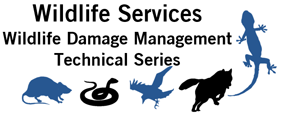United States Department of Agriculture: Animal and Plant Health Inspection Service

Wildlife Damage Management Technical Series
Date of this Version
10-2019
Document Type
Article
Citation
Klug, P.E., Bukoski, W.P., Shiels, A.B., Kluever, B.M. and S.R. Siers. 2019. Rose-Ringed Parakeets. Wildlife Damage Management Technical Series. USDA, APHIS, WS National Wildlife Research Center. Fort Collins, Colorado. 16p.
Abstract
Rose-ringed parakeets (Psittacula krameri; hereafter RRPA; Figure 1) are an invasive species in the United States, present in Alabama, Louisiana, Texas, and Virginia, and with established populations in California, Florida, and Hawaii. They are also the most successful species of invasive parakeet, worldwide. RRPA can cause significant damage to agriculture, including grains, oilseeds, fruits, and ornamental plants. Large flocks of RRPA roost near human infrastructure resulting in concerns about human health and safety (e.g., collisions with aircraft, disease transmission, feces accumulation, and noise complaints). The population growth and spread of RRPA is of conservation concern given the potential impact on native wildlife, spread of invasive plant seeds, and destruction of native plants.
RRPA are an agricultural pest with a generalist diet and feeding behaviors that increase the severity of crop damage (Figure 2). RRPA damage corn by feeding on the anthers and pollen of the inflorescence, the tender cob stage, and the milky cob stage up until maturity. RRPA perch on sunflower heads and access the seeds that are hulled prior to consumption. Damage to tree fruits is greater on the top branches compared to the side and bottom branches. RRPA attack stored grains and eat unripe fruit, extending the damage period. RRPA often discard partially-eaten food. Crop damage varies with some fields experiencing more damage due to the timing of crop maturity or location (e.g., field or orchard edges have greater damage than interior). RRPA strip roosting trees (e.g., royal palms in Kauai) of their leaves. A long-term management plan that involves sustained lethal control is necessary to reduce invasive RRPA populations and their damage. In the meantime, the following damage management methods may provide short-term relief from RRPA damage.
Included in
Behavior and Ethology Commons, Biodiversity Commons, Other Animal Sciences Commons, Other Ecology and Evolutionary Biology Commons, Population Biology Commons, Terrestrial and Aquatic Ecology Commons


Comments
U.S. government work.